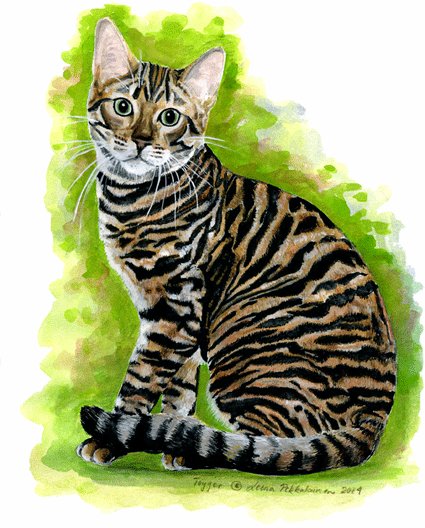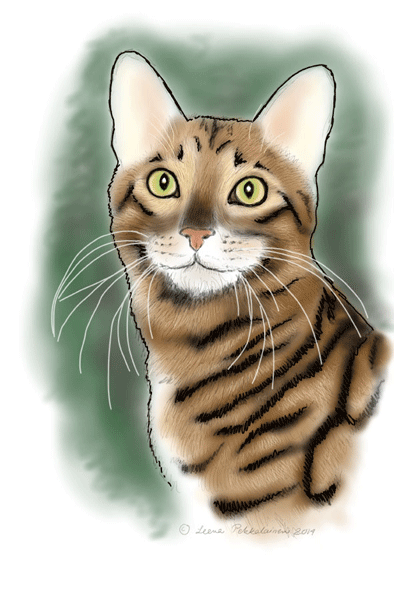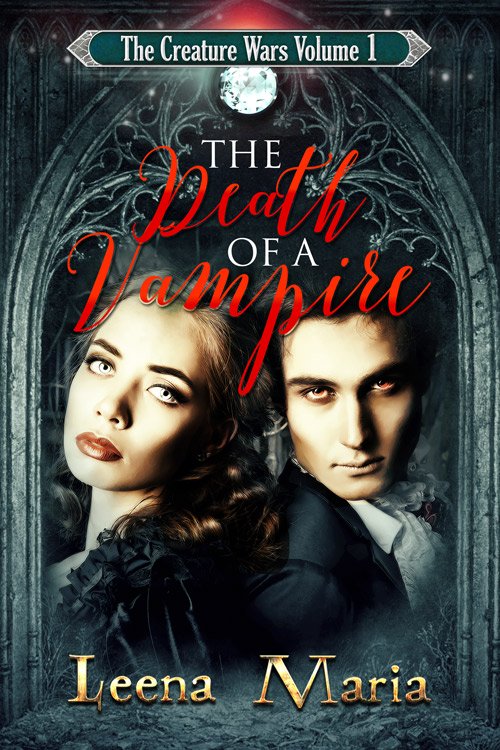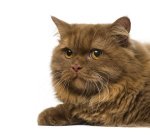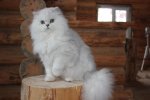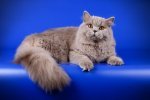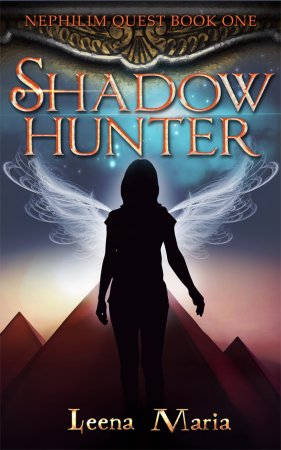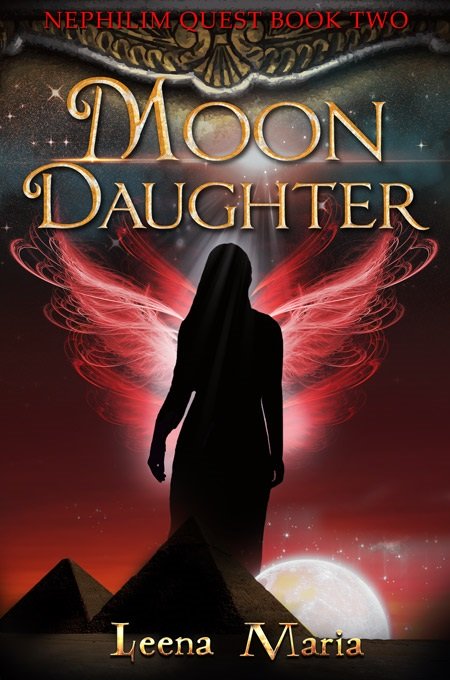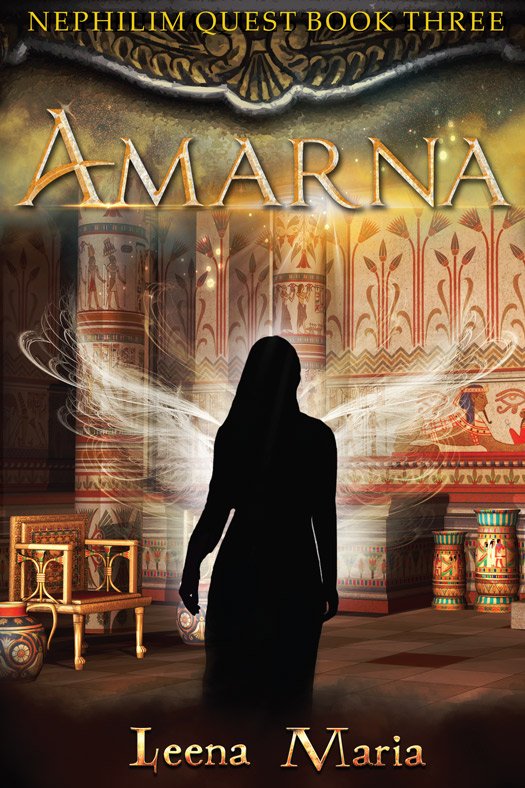Toyger Cat History
I have to admit Toyger cat was not a familiar breed to me at all, when I started researching it. The name brought to mind a toy cat, or small cat, like a munchkin. Imagine my surprise then, when I saw a picture of the Toyger for the first time.
I was awestruck. I looked at the shiny, plush, orange-colored undercoat, the amazing stripes, the intelligent eyes… It was like no other cat I had seen, this cat had the "wow"-factor big time!
And for a moment I felt what most cat lovers probably feel when first seeing a Toyger cat: "I want one!" Well, as we already have three cats in our home, I sushed the thought away (with a sigh) and started studying the breed to write these pages.
This cat really does resemble a tiger - yet it is still a "tiger in process", as the breeding program is still young, and there are not that many breeders yet worldwide. Together they strive to create a domestic cat that looks as much like a tiger as possible - and it seems obvious they are well along the way. Some of the features they have achieved were not thought to be possible to breed into domestic cats.
How Toyger Cat Was Created
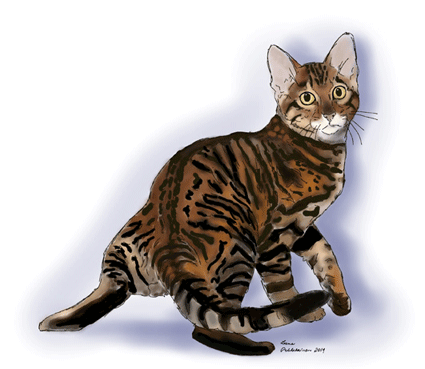 |
But how did this breed "come to be"?
It was Judy Sugden of the EEYAAS Cattery in USA whom we have to thank for this gorgeous breed. Judy had seen breed-developing up close, being the daughter of Jean Mill who created the beautiful Bengal cat breed.
|
As it happened, Judy Sugden was working on clarifying the mackerel marking on tabby cats in the late 80's. She noticed that one of her cats had unsual markings - normally there are no distinct markings on cats' temples (I know I was surprised – I had to go and check several tabby cat pictures to see this really is so). But Judy’s cat Millwood Sharp Shooter had what she had not been seen before: two tabby spot markings on her temples.
Now if "ordinary" people had seen these spots, they would probably have gone unnoticed. But to a cat breeder they were a genetic sign of a very interesting possibility. And Judy Sudgen 's thoughts turned to the big wild cats - and to the tiger.
The tiger has circular facial markings - the unique tiger-pattern that sets it apart from all other big cats. And they certainly have stripes on the temples too. As an experienced breeder Judy saw the beginnings of the circular facial pattern of the tiger.
(Raise your hand, if you have ever saw a red tabby cat with a mackerel pattern that was called Tiger! Yes, quite a few have. Before Toygers red mackerel tabbies were often called tigers)
And so Judy began her attempts to develop a new breed. Her first cats in this breeding program were a Domestic Shorthair (DHS) tabby Crapmetal, and a big-boned Bengal Millwood Rumpled Spotskin (or SBT aka Studbook Traditional Bengal). Still it is important to empasize the Toyger is not a striped Bengal. And it is definitely not "just another tabby cat".
To add to the breeding line, a tomcat was imported from Kashmir, India - his name was Jammu Blu. He also had rare markings for a tabby cat: normally tabbies have a "tabby M" (or Scarab as it is called in the Egyptian Maus because of the marking's uncanny resemblance of the sacred Scarab beetle of the ancient Egyptians) on their forehead. What Jammu Blu had was clear spotting on top of his head instead of lines.
The Breeding Work Continues
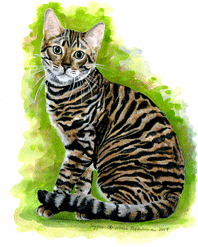 |
Later on the number of domestic cats chosen for the breeding program rose to about 40. All of these had some desirable trait which the breeders tried to blend into the new breed in development. So at first domestic outcrosses were used, but nowadays this is no more allowed.
|
Judy was not alone in developing the new breed - other names connected tothese early stages are Anthony Hutcherson and Alice McKee. And later on breeders around the world have taken the development of beautiful cat into their hearts.
Judy did not just randomly start breeding - she sat down and planned what she would like the Toygers to look like. With this clear picture established she could then better search for specific features in cats to use them in her breeding program. This explains why the Toyger is called a "designer cat". It really was pre-designed and not another "Garfield", so to speak...
And the name Toyger? Where did that come from? Well - from putting Toy and Tiger together. (In the early stages the breed was called the California Toyger)
And no - there is no tiger blood in the Toyger cat (I am not sure anyone could seriously think so, but I suppose it is good to mention. It would simply not be genetically possible.) But there is a drop of wild blood in the mix, because of the Bengal ancestry. Asian Leopard Cat was used in creating the Bengal, after all.
There is also a very worthy cause behind the Toyger breeding - Judy Sudgen says her motivation for developing the breed was to inspire tiger conservation. Many breeders give part of of the price of the kittens to tiger conservation. So you could say this beautiful breed is the good-will ambassador of its larger cousin which is in dire need of help to prevent it from becoming extinct.
The life expectancy of a Toyger cat is around 10-15 years - the breed is still in its early stages, so it will take a while to see where this will settle. At the moment this breed seems to have the normal age of a "randomly bred" cat.
No serious breed-related serious illnesses have been spotted in Toyger cat breed but as with any cats thre is a possibility of health issues. Breeders, of course, do their best to keep the breed healthy, and as many cats were used in creating the breed, the genetic variety is also greater, which usually is a good thing health-wise.
What is a Toyger like as a pet? Read more here.
If you want to read more about the looks of this little tiger, go here.
Here is page for the Toyger breeders.
Back to Homepage from Toyger Cat History
Back to Rare Cat Breeds from Toyger Cat History
I wish to thank Helmi Flick for the permission to use her photographs as reference for the Toyger painting shown on this page.
Space Witches series
The Seven Shabtis series
The Creature Wars series
Leena's Books
Tutankhamun
|
This book travels with the King Tut - Treasures of the Golden Pharaoh exhibition on his world tour of ten cities from March 2018 onwards |
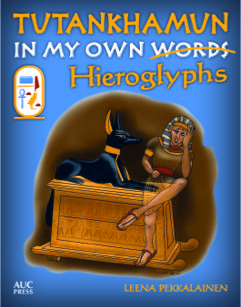 |
|
Tutankhamun: In My Own Hieroglyphs tells the story, for older children, of the life and afterlife of the famous young pharaoh in his own words. Tutankhamun tells us about the trouble he got into as a child in Akhenaten's palace in the new city of Akhetaten, and how he became a boy pharaoh. As we learn, his life changed a lot when he died as a teenager, and long years of boredom started in his tomb with only his pet monkey Fingers and his treasure for company. He did meet some of the Egyptian gods, of course, and had fun scaring off tomb robbers, but it was mostly rather dull. Then one day, some new and strange people, including a Mr. Howard Carter, arrived and began to take all the treasures out of his royal tomb. Fortunately, through the eyes of his beautiful golden mask, Tutankhamun, could have fun again traveling around the world |
Mr Mummific
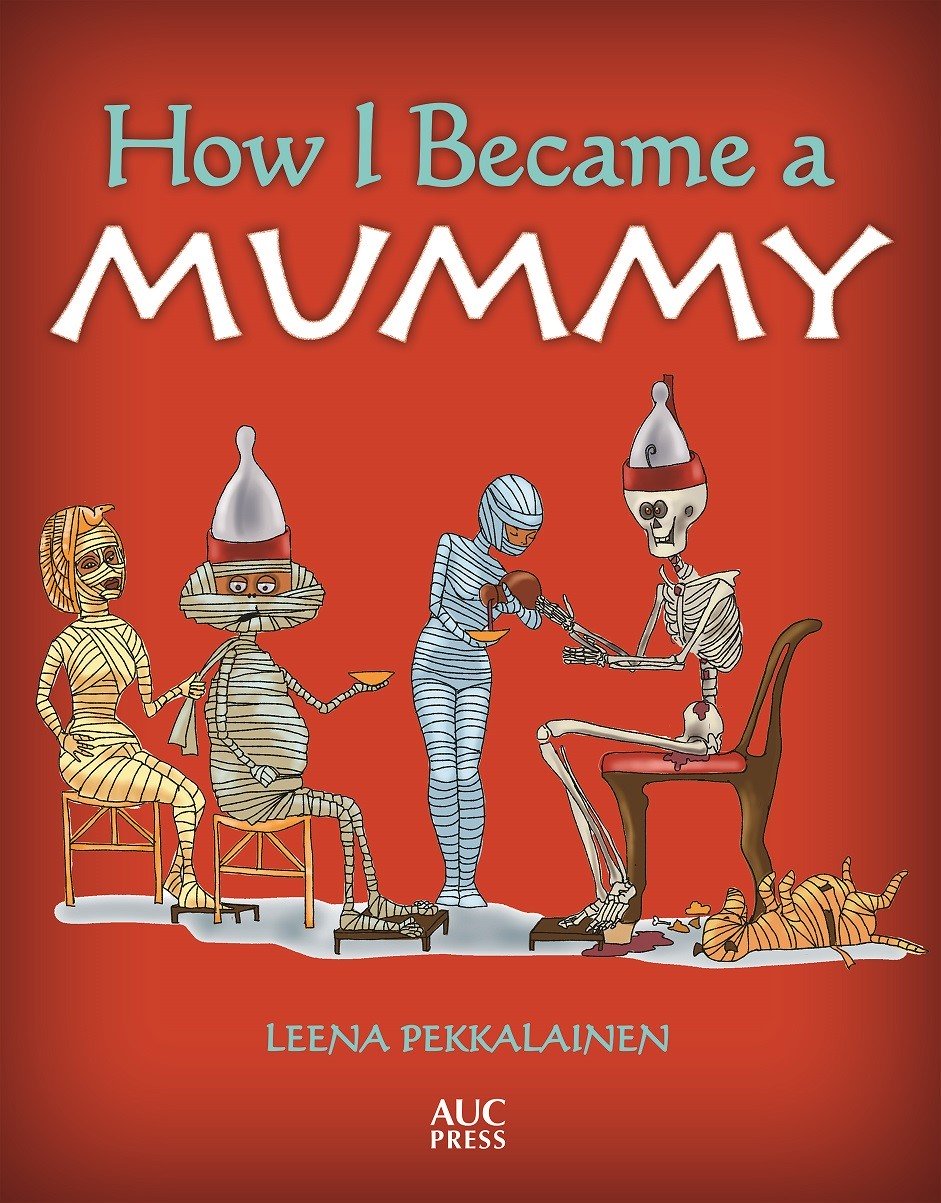
|
An ancient friend of mine, Mr Mummific dictated a book about how he became a mummy - and I was his scribe and artist. The book is available at Amazon.com and Amazon.co.uk On my other website www.ancientagypt101.com he continues his stories about life in ancient Egypt. |
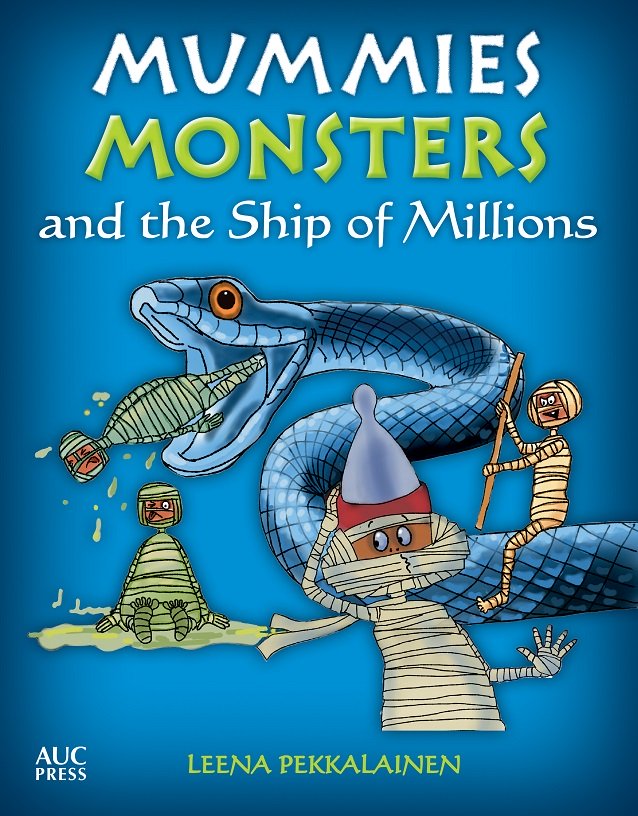
|
Another hilarious adventure for children with Mr Mummific, the mummy with attitude. He now tells the story of his mishaps, misunderstandings and misadventures as he leaves his tomb through the False Door to embark on the complicated and dangerous journey to the Afterlife aboard the magnificent Ship of Millions. Find the book at Amazon.com and Amazon.co.uk |
The Nephilim Quest Series
The first book in an epic fantasy series based on human mythology. The search for the mythical Watchers, the angels who fathered the Nephilim, the half-angels. A story that moves on three levels - our times, ancient Greece and ancient Egypt.
Preview Nephlim Quest 1: Shadowhunter online
***
My Author Website at leenasbooks.com
If you wish to have a closer look at the painting and other cat art, click here.
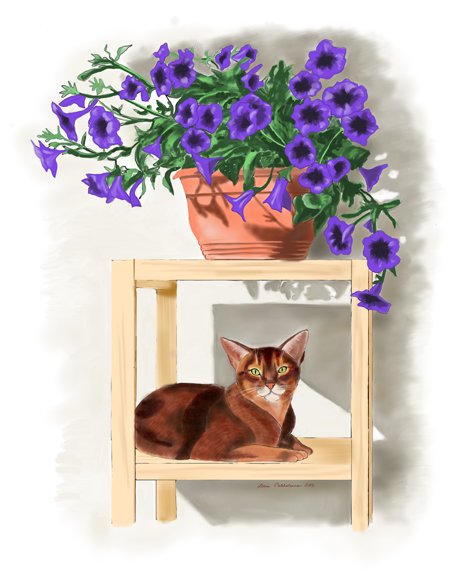
If you are looking for demanding coloring, check:
Online Coloring Books Magazine - No.1
It shows you step by step how to color this pretty Abyssinian cat with flowers. Each page has a color sample, and all the techniques are explained.
